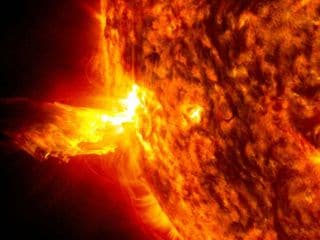- Home
- Science
- Science News
- Rising Rocket Launches May Delay Ozone Layer Recovery, Study Finds
Rising Rocket Launches May Delay Ozone Layer Recovery, Study Finds
The rapid rise in global rocket launches may be harming the ozone layer more than previously thought.

Photo Credit: SpaceX / Keystone
A growing number of rocket launches may be compromising the ozone layer's recovery
With the increase in global rocket launches, scientists are reporting concerns about their impact on the ozone layer, our planet's natural shield against harmful UV radiation. The research team, which includes Sandro Vattioni and other scientists, put emphasis on the environmental risks that can increase with the rocket emissions are still now underestimated. However, it can be addressed with proactive and coordinated efforts. With a boom in the commercial space industry, there comes opportunity; however, with this comes a lot of threat to the environment by causing ozone layer depletion during the launch and re-entry of the spacecrafts.
Rocket Emissions Pose a Growing Threat to the Ozone Layer
As per Phys org, Rockets release pollutants as soot and chlorine into the atmosphere's middle and upper parts. These particles remain for longer than the ground ones and catalyse the chemical reactions that damage the ozone layer. The re-entry of the satellite releases metal particles and nitrogen oxides, which in turn do more damage. The current models don't usually account for the effects through re-entry, making it an overall cost to the environment, which is higher than the estimated one.
Research has been conducted through the climatic simulations show that if rocket launches increase to 2,040 yearly by the end of 2030. The global thickness of the ozone layer is yet healing from the previous damage caused by CFCs, which re now banned, however, full recovery will still not be achieved even after 40 years. The unchecked emissions might be a cause to the recovery delay.
Global Cooperation Needed to Protect Earth's Atmospheric Shield
Rocket fuel selection is significant, as the majority of rockets utilise propellants that have soot and chlorine, which are depleting the ozone layer. A small percentage utilised cryogenic fuels like hydrogen and oxygen as liquids, which are thought to have less of an effect on the ozone layer; however, it is difficult to handle.
For protecting the ozone layer, the space industry may have transitioned to cleaner fuels, check emissions and stick to the strict guidelines. The Montreal Protocol has helped us phase out CFCs, where worldwide collaboration is needed to save the atmosphere of Earth, with the advancement in space exploration.
Get your daily dose of tech news, reviews, and insights, in under 80 characters on Gadgets 360 Turbo. Connect with fellow tech lovers on our Forum. Follow us on X, Facebook, WhatsApp, Threads and Google News for instant updates. Catch all the action on our YouTube channel.
Related Stories
- Samsung Galaxy Unpacked 2025
- ChatGPT
- Redmi Note 14 Pro+
- iPhone 16
- Apple Vision Pro
- Oneplus 12
- OnePlus Nord CE 3 Lite 5G
- iPhone 13
- Xiaomi 14 Pro
- Oppo Find N3
- Tecno Spark Go (2023)
- Realme V30
- Best Phones Under 25000
- Samsung Galaxy S24 Series
- Cryptocurrency
- iQoo 12
- Samsung Galaxy S24 Ultra
- Giottus
- Samsung Galaxy Z Flip 5
- Apple 'Scary Fast'
- Housefull 5
- GoPro Hero 12 Black Review
- Invincible Season 2
- JioGlass
- HD Ready TV
- Laptop Under 50000
- Smartwatch Under 10000
- Latest Mobile Phones
- Compare Phones
- OnePlus 15R
- Realme Narzo 90x 5G
- Realme Narzo 90 5G
- Vivo S50 Pro Mini
- Vivo S50
- OPPO Reno 15c
- Redmi Note 15 5G
- Redmi Note 15 Pro 5G
- Asus ProArt P16
- MacBook Pro 14-inch (M5, 2025)
- Infinix Xpad Edge
- OnePlus Pad Go 2
- OnePlus Watch Lite
- Just Corseca Skywatch Pro
- Acerpure Nitro Z Series 100-inch QLED TV
- Samsung 43 Inch LED Ultra HD (4K) Smart TV (UA43UE81AFULXL)
- Asus ROG Ally
- Nintendo Switch Lite
- Haier 1.6 Ton 5 Star Inverter Split AC (HSU19G-MZAID5BN-INV)
- Haier 1.6 Ton 5 Star Inverter Split AC (HSU19G-MZAIM5BN-INV)

















